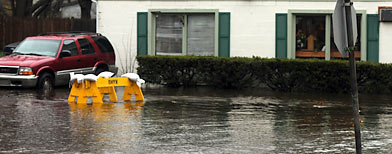The Most Expensive Home Insurance Perils


Depending on where you live in the United States, your home may be at risk to a number of natural disasters that could damage or destroy it. Beyond that, a lifetime of memories and irreplaceable items inside your home may be even harder to lose than the house itself. Insurance affords some protection against these threats, and the rate you pay will be a function of where you live.
According to Flora Richards-Gustafson of Rapid Refile, the following are the most significant risks to homeowners due to natural disasters:
More from Investopedia |
Northeast - Severe Winter Storms
In addition to knocking out power and paralyzing homes and businesses, these storms often cause significant water damage in two ways. First, pipes may burst due to cold temperatures. Second, the snowmelt in the spring may overflow rivers and reservoirs.
South (including Atlantic and Gulf Coasts) - Hurricanes
The season runs for six months starting on June 1, and may feature many tropical storms that never reach hurricane strength. High wind damage and flooding from heavy rains are the major risks.
Midwest (including Great Plains) - Tornadoes
In addition to the risk of wind damage and flooding, tornadoes often cause fires when they rupture and destroy gas and power lines. Flooding is also caused in these areas when heavy rainfall and snowmelt overwhelm a land mass that is normally relatively dry. Swollen rivers and broken levees in low-lying areas are a continuous threat.
West Coast - Earthquakes and Wildfires
This area has the most active faults, and a significant quake has a ripple effect that may result in flooding, fires, collapsing structures and power loss.
The region is also prone to wildfires, due to the prevalence of dry brush and desert-like conditions. Wildfires are often accompanied and fueled by high winds that further compound the damage.
Financial Impact
The chart below ranks homeowners insurance claims by frequency and provides the average size of each type of claim. It is based on the weighted average of homeowner losses from 2003-2007 for multiple peril policies (excluding tenants and condominium owners).
| Cause of loss and type of coverage (a) | Claim frequency (b) | Claim severity (c) |
| Wind and hail (property damage) | 2.13 | $7,163 |
| Water damage and freezing (property damage) | 1.42 | $5,531 |
| All other property damage (d) | 1.06 | $3,532 |
| Fire, lightning and debris removal (property damage) | 0.52 | $24,153 |
| Theft (property damage) | 0.50 | $2,494 |
| Bodily injury and property damage (liability) | 0.14 | $15,854 |
(a) Types of homeowners coverages are property damage and liability
(b) Claims per 100 house years (policies)
(c) Accident year incurred losses, excluding loss adjustment expenses (indemnity costs per accident year incurred claims)
(d) Includes vandalism and malicious mischief
Chart provided by Insurance Information Institute (Source: Insurance Services Office, Inc.)
Flooding
During the past decade, the Federal Emergency Management Agency has declared an average of 56 disasters per year. Of the 59 disasters declared in 2009, 41 involved flooding primarily caused by severe storms and tornadoes. In spite of this compelling statistic, Geoff Gordon, owner and president of Andrew G. Gordon Insurance, says that "there is one large peril where insurance is readily available, but consumers choose to ignore - flood insurance."
The National Flood Insurance Program subsidizes flood policies through participating companies, but Gordon says that "too many consumers choose to self-insure this risk." From his vantage point in the northeast, he views this as "incredible behavior since the chances of a flood are much greater than the chances of a hurricane."
Water Damage
In most areas of the country, the risk of a serious water leak exceeds the risk of a naturally caused flood. According to Todd Triano, vice president for Chartis Insurance, "the most commonly reported homeowner claim in my experience is water damage. For example, a pipe may burst inside the wall or a hot water heater on an upper level can leak and cause significant damage to the building and personal property."
To assist homeowners to protect themselves, Triano notes that "plumbing products have surfaced in the marketplace to help homeowners monitor their water usage and/or shut off the water completely if a leak is discovered by smart sensors." Homeowners can also purchase "smart sump pumps" that email or send a text message when the power goes out, alerting the owners to check and engage a backup sump pump.
The Bottom Line
While there are many natural perils facing homeowners around the country, the most common damage is caused by wind and water. Whether it's a hurricane, a tornado, a dam cracked by an earthquake or a broken pipe, the end result can be a destroyed or severely-damaged home.
http://realestate.yahoo.com/promo/the-most-expensive-home-insurance-perils
Tidak ada komentar:
Posting Komentar